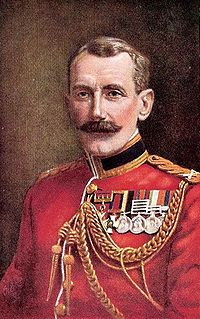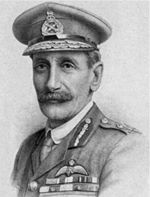- David Henderson (British Army officer)
-
David Henderson 
Brigadier-General Sir David HendersonBorn 11 August 1862
Glasgow, ScotlandDied 17 August 1921 (aged 59)
Geneva, SwitzerlandAllegiance  United Kingdom
United KingdomService/branch British Army, Royal Air Force Rank Lieutenant General Commands held 1st Infantry Division
Royal Flying CorpsBattles/wars World War I Awards Knight Commander of the Order of the Bath
Knight Commander of the Royal Victorian Order
Distinguished Service OrderOther work Director-General of Red Cross Societies Lieutenant General Sir David Henderson KCB, KCVO, DSO, LLD (11 August 1862 – 17 August 1921) was an officer in the British Army who came to be considered as the leading authority on tactical intelligence during the early years of the 20th century. Henderson was also the first commander of the Royal Flying Corps in the field and was instrumental in establishing the Royal Air Force as an independent service.[1]
Contents
Early and family life
David Henderson was born in Glasgow on 11 August 1862 into a shipping family. His father, also called David, was a joint owner of the Clydeside ship builders David and William Henderson and Company.[2]
Henderson entered the University of Glasgow in 1877 at the age of just fifteen. While at university, Henderson read engineering and in his fourth year (1880–1881) he studied civil engineering and mechanics as well as office and field work in engineering. Henderson — for reasons unbeknownst to history — left to attend Sandhurst instead of graduating from the University of Glasgow.[3]
In 1895, Henderson married Henrietta Caroline Dundas, later known as Dame Henrietta Henderson. She was a Dame of Grace, Order of St. John of Jerusalem (D.G.St.J.) and was knighted in 1919 as a Dame Commander of the Order of the British Empire (DBE).[4] The couple had three children, Ian Henderson who also joined the Royal Flying Corps, reaching the rank of captain, Stewart Peter Henderson and Anabel Margret Henderson. Ian Henderson predeceased his parents, dying in a flying accident in June 1918. Dame Henrietta Henderson died on 14 April 1959.
Military career
Following officer training at the Royal Military College Sandhurst, Henderson was commissioned into the British Army on 25 August 1882, joining the Argyll and Sutherland Highlanders. Henderson was a member of the Nile Expedition of 1898 and was wounded at the Siege of Ladysmith during the Boer War.[5] In February 1901 Kitchener appointed Henderson his Director of Military Intelligence, a post he held until the end of the Boer War.[6] His subsequent works, Field Intelligence: Its Principles and Practice (1904) and The Art of Reconnaissance (1907), did much to establish his reputation as the Army's authority on tactical intelligence.[1]
In 1911, at the age of 49, Henderson learned to fly, making him the world’s oldest pilot at that time.[1] In 1913 the control of military aviation was separated from the responsibilities of the Master-General of the Ordnance.[7] A new Department of Military Aeronautics was established and Henderson was appointed the first Director[8] and, with the outbreak of World War I, he took up command of the Royal Flying Corps in the field. On 22 November 1914, Henderson was appointed General Officer Commanding the 1st Infantry Division and his Chief of Staff Frederick Sykes took up command in his stead. However, Henderson did not spend long commanding the 1st Infantry Division. The decision to post Henderson and replace him with Sykes was not to Lord Kitchener's liking and he ordered a reversal of the appointments. On 20 December 1914, Henderson resumed command of the Royal Flying Corps in the Field and Sykes was once again his Chief of Staff.[citation needed]
In 1915 Henderson returned to London to resume his London-based duties as Director-General of Military Aeronautics,[5] which Sefton Brancker had been performing in his absence. This meant that when, in 1917, General Jan Smuts was writing his review of the British Air Services, Henderson was well placed to assist. Whilst seconded to General Smuts, Henderson wrote much of what came to be called the Smuts Report.[1][5] It has been argued that he had a better claim to the informal title "father of the Royal Air Force" than Sir Hugh Trenchard.[1] Trenchard himself believed that Henderson deserved the accolade.[9]
In January 1918, Henderson was made a member of the Air Council,[5] serving as its vice-president. However, having not been appointed as the RAF's Chief of the Air Staff, Henderson resigned from the Air Council in April, citing his desire to escape the atmosphere of intrigue at the Air Ministry.[10]
Following his departure from the Air Council, Henderson returned to France where he served until October 1918. After the armistice, Henderson served as a military counsellor during the Paris Peace Conference[10] until the signing of the Versailles Treaty in June 1919. Henderson then became Director-General of the League of Red Cross Societies in Geneva, where he died in 1921, aged 59.[5]
Honours
Henderson was awarded the Distinguished Service Order in 1902 for his work during the Second Boer War.
In March 1918, Henderson accepted the honorary position of Colonel of the Highland Light Infantry.[11]
References
- ^ a b c d e "Sir David Henderson". Lions Led By Donkeys. Centre for First World War Studies, University of Birmingham. http://www.firstworldwar.bham.ac.uk/donkey/henderson.htm. Retrieved 2007-07-26.
- ^ Biography of Lieutenant General Commanding Sir David Y Henderson
- ^ University of Glasgow archives
- ^ The Peerage bio
- ^ a b c d e Malcolm Barrass. "Lieutenant General Sir David Henderson". Air of Authority - A History of RAF Organisation. http://www.rafweb.org/Biographies/HendersonD.htm. Retrieved 2007-07-26.
- ^ The Second Anglo-Boer War Military Intelligence
- ^ Joubert de la Ferté, Philip (1955). The Third Service. London: Thames and Hudson. p. 15.
- ^ 1911 Encyclopedia
- ^ Sir Peter Squire. "From Spitfire to Eurofighter - The RAF's Legacy". RUSI Journal. Defence Data Ltd. http://defence-data.com/features/fpage41.htm. Retrieved 2007-07-26.
- ^ a b Smith, Richard. "Henderson, Sir David (1862–1921)". Oxford Dictionary of National Biography. http://www.oxforddnb.com/view/article/33808. Retrieved 2007-10-08.
- ^ "The Highland Light Infantry (City of Glasgow Regiment)". Regiments.org. http://www.regiments.org/regiments/uk/inf/071HLI.htm. Retrieved 2007-07-26.[dead link]
External links
- Air of Authority - A History of RAF Organisation - Lt Gen Henderson
- Oxford Dictionary of National Biography - Henderson, Sir David (requires login)
- Centre for First World War Studies, Birmingham University - Sir David Henderson
- University of Glasgow - Biography of Henderson
- thePeerage.com - Lt. Gen. Sir David Henderson
Military offices Preceded by
C V HumeDirector of Military Intelligence
For the Boer War
February 1901 – May 1902End of Boer War Preceded by
Sir Archibald MurrayDirector of Military Training
1912 – 1913Succeeded by
Sir William RobertsonNew title
Directorate establishedDirector-General of Military Aeronautics
1 September 1913 – 18 October 1917Succeeded by
J M SalmondNew title
Start of WW1General Officer Commanding the Royal Flying Corps in the Field
5 August 1914 – 22 November 1914Succeeded by
F H Sykes
As Officer CommandingPreceded by
Herman Landon
(Acting)General Officer Commanding the 1st Infantry Division
22 November – 18 December 1914Succeeded by
Richard HakingPreceded by
F H Sykes
As Officer CommandingGeneral Officer Commanding the Royal Flying Corps in the Field
20 December 1914 – 19 August 1915Succeeded by
H M TrenchardHonorary titles Preceded by
Sir William CampbellColonel of the Highland Light Infantry
1918 – 1921Succeeded by
G G A EgertonNon-profit organization positions New title
League foundedDirector-General of the League of Red Cross Societies
1919 – 1921Succeeded by
Sir Claude HillCategories:- 1862 births
- 1921 deaths
- Alumni of the University of Glasgow
- British Army personnel of the Mahdist War
- British Army personnel of the Second Boer War
- Royal Flying Corps officers
- British Army World War I generals
- Royal Air Force World War I generals
- Companions of the Distinguished Service Order
- Knights Commander of the Order of the Bath
- Knights Commander of the Royal Victorian Order
- People from Glasgow
- Recipients of the Order of the Crown of Italy
- Sandhurst graduates
- Argyll and Sutherland Highlanders officers
Wikimedia Foundation. 2010.

